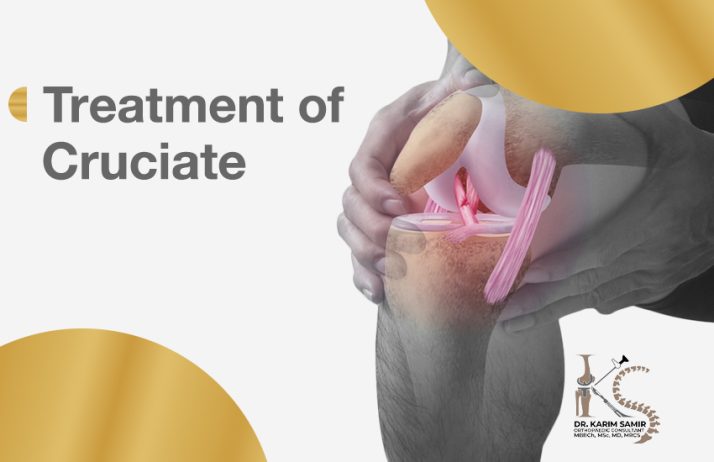Anterior and posterior cruciate ligament injuries: causes, symptoms, methods of treatment and rehabilitation with the best orthopedic doctor in Cairo-Dr. Karim Samir
Introduction
Cruciate ligament injuries are one of the most common injuries that affect the stability of the knee, and most often occur as a result of sudden movements or sports injuries. Whether you have an anterior or posterior cruciate ligament tear, accurate diagnosis and proper treatment are the key to complete recovery. In this article, we will discuss in detail the causes and symptoms of cruciate ligament injuries, diagnostic methods, surgical and non-surgical treatment, postoperative rehabilitation, the cost of surgery, highlighting the experience of Dr. Karim Samir, consultant orthopedic surgeon in Cairo.
What is the cruciate ligament
The cruciate ligament is one of the main ligaments of the knee, there are two basic types:
- Anterior cruciate ligament (ACL): it is located at the front of the knee and helps stabilize the forward movement of the knee.
- Posterior cruciate ligament (PCL): it is located at the back of the knee and prevents the posterior sliding of the shin bone.
Causes of cruciate ligament injuries
Cruciate ligament injuries can occur as a result of several factors, including:
- Sudden movements such as quickly changing direction while running.
- Incorrect landing after jumping, which puts a huge strain on the knee.
- Violent knee sprain during sports, especially in football and basketball.
- Traffic accident injuries that lead to rupture of the posterior cruciate ligament.
- Direct fall on the knee, which can cause severing of the posterior cruciate ligament.
Symptoms of cruciate ligament injuries
Symptoms depend on the severity of the injury, they include:
- Severe knee pain, especially when trying to walk or change direction.
- Swelling of the knee a few hours after the injury.
- Feeling of instability of the knee or” betrayal of the knee ” while walking.
- Hearing a crackling or popping sound at the moment of injury.
- Difficulty in fully bending or extending the knee.
How to diagnose cruciate ligament injury
The prognosis for a cruciate ligament rupture depends on:
- Clinical examination: the doctor performs tests such as the “Luckman test” and the”back pull test” to assess the stability of the knee.
- X-rays: help detect concomitant fractures but do not show the ligament injury itself.
- Magnetic resonance imaging (MRI): it is the most accurate in determining the degree of rupture and whether there are other injuries such as a meniscus tear.
Treatment of cruciate ligament injuries
Treatment depends on the severity of the injury and factors such as age and level of sports activity.
- Conservative (non-surgical)treatment
- Rest and avoid violent activities.
- Use cold compresses to reduce swelling.
- Exercises strengthen the muscles surrounding the knee.
- Use a medical brace to support the knee during movement.
- Anti-inflammatory drugs to relieve pain and swelling.
- Surgical treatment: cruciate ligament reconstruction operation
In severe cases or in athletes, surgical intervention is the optimal solution.
- The cruciate ligament is repaired or reconstructed using a tendon from the body, such as the tendon of the posterior muscle or the patellar tendon.
- The operation is performed laparoscopically, which reduces the recovery period and helps to quickly restore knee function.
Rehabilitation after cruciate ligament surgery
The rehabilitation stage after the operation is necessary to restore full mobility of the knee.
- First week: control pain and swelling with ice and appropriate medications.
- The second – sixth week: exercises to improve range of motion and strengthen muscles.
- Sixth week-third month: advanced exercises to improve balance and strength.
- After 6 months: gradual return to sports under the supervision of a specialist.
The cost of cruciate ligament surgery in Egypt
The cost of cruciate ligament surgery in Egypt varies based on several factors:
- The complexity of the condition (complete or partial rupture).
- Type of hospital or medical center.
- The cost of anesthesia and surgical instruments used.
- The experience of the surgeon, where Dr. Karim Samir is one of the best doctors specializing in knee surgery in Cairo.
Prevention of cruciate ligament injuries
To avoid cruciate ligament injuries, some preventive guidelines can be followed:
- Strengthen the thigh and knee muscles through aerobic exercise.
- Practice a warm-up before starting aerobics.
- Avoid violent movements that increase the risk of knee injuries.
- Use the right shoes during sports to avoid slipping.
Why choose Dr. Karim Samir for the treatment of cruciate ligament injuries
- More than 10 years experience in orthopedics and playground injuries.
- Member of the Swiss Society of fracture surgery, which ensures the use of the latest surgical techniques.
- The success of hundreds of cases in laparoscopic cruciate ligament surgeries with the highest cure rates.
Book your appointment now!
If you are suffering from a cruciate ligament injury and are looking for the best orthopedic doctor in Cairo, do not hesitate to book a consultation with Dr. Karim Samir.
- 📍 Address: building 9106 – Street 9 – Mokattam – Cairo.
- 📞 For reservations and inquiries: 01020013313.
- 📍 Hurghada clinic: Capital Medical Center (CMC) – Hejaz Street – next to the covered lounge.
- Clinic number in Hurghada: 01030863088.
Do not let the injury affect your Sports Life, restore your normal activity with Dr. Karim Samir!
